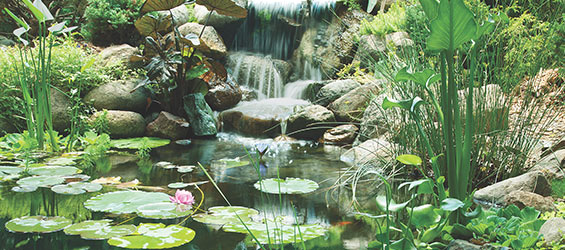
Whether it is murky, green pond water or the stringy slimy stuff, nothing challenges pondowners more than aggressive nuisance algae growth. While there are many methods to combat nuisance algae, they may not be as effective unless you address the root cause. Learn how to maximize your efforts when armed with the science behind successful algae control.
Shocking Truth
about Algae Control
While it may sound a bit counter intuitive, effective algae control is not really about controlling algae. Rather, it is about controlling conditions that support aggressive algae growth. In fact, algae provide a solution to reducing the real underlying problem, excess nutrients. Algae are prolific and opportunistic organisms that take advantage
of aquatic systems that are out of balance, feeding and thriving on an abundance of nutrients.
Nuisance algae proliferate, quickly turning a once beautiful pond into an unsightly green mess – as long as there is a constant supply of nutrients. If algae should use up the excess nutrients or are cut off from it, aggressive algae growth comes to a halt. Simply put, a low-nutrient environment is not capable of supporting aggressive algae growth.
Create a Low-Nutrient Environment
The first step towards effective algae control is to identify common sources of excess pond nutrients and to reduce them. The most common sources of algae-fueling nutrients include uneaten food, fish waste, organic debris (sludge/muck), and dead or decaying vegetation. Warmer water temperatures accelerate the breakdown of these materials so it is essential to take corrective action even if you are not currently experiencing aggressive algae growth.
Invest extra time in spring to remove organic waste buildup (sludge/muck). As soon as pond water temperatures are consistently at or above 60°F, begin cleaning the bottom of your pond. Remove large organic debris such as fallen
leaves with a pond net and then remove sludge/muck buildup with a pond vacuum. The longer sludge/muck and decaying vegetation remain in your pond, the greater the amount of algae-fueling nitrogen compounds and phosphate are released into the pond water, creating a veritable buffet for algae in summer. Stop potential aggressive algae growth in summer by eliminating these food sources in spring.
Additional Steps to Boost Pond Water Quality
Removing organic solids is merely the first step. Dissolved organic nutrients released from decomposing organics must also be removed to curb aggressive algae growth. Employ chemical filter media such as our Premium Activated Carbon, to effectively remove dissolved organic nutrients. Target and eliminate the algal nutrient phosphate, with our commercial-strength PhosPure phosphate removing media. Sustained use of chemical filter media
improves pond water quality, creating a healthy, balanced environment where algae are unable to proliferate.
|



